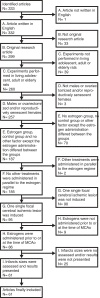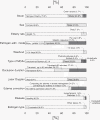Impact of methodology on estrogens' effects on cerebral ischemia in rats: an updated meta-analysis
- PMID: 24495535
- PMCID: PMC3975994
- DOI: 10.1186/1471-2202-15-22
Impact of methodology on estrogens' effects on cerebral ischemia in rats: an updated meta-analysis
Abstract
Background: Although most animal stroke studies have demonstrated potent neuroprotective effects of estrogens, there are a number of articles reporting the opposite. In 2009, we made the case that this dichotomy was related to administered estrogen dose. Several other suggestions for the discordant results have also been propagated, including the age of the experimental animals and the length of hypoestrogenicity prior to estrogen administration. These two suggestions have gained much popularity, probably because of their kinship with the window of opportunity hypothesis, which is commonly used to explain the analogous dichotomy among human studies. We were therefore encouraged to perform an updated meta-analysis, and to improve it by including all relevant variables in a large multiple regression model, where the impact of confounders could be controlled for.
Results: The multiple regression model revealed an indisputable impact of estrogen administration mode on the effects of estrogens in ischemic stroke. Subcutaneous slow-release pellets differed from the injection and silastic capsule treatments in terms of impact of estrogens on ischemic stroke, showing that the first mentioned were more prone to render estrogens damaging. Neither the use of elderly animals nor the adoption of longer wash-out periods influenced estrogens' effects on experimental ischemic stroke in rats.
Conclusions: We conclude that the discordant results regarding estrogens' effects in rat models of ischemic stroke are a consequence of differences in estrogen administration modes. These results are not only of importance for the ongoing debate regarding menopausal hormone therapy, but also have an important bearing on experimental stroke methodology and the apparent translational roadblock for suggested stroke interventions.
Figures




Similar articles
-
Different methods for administering 17beta-estradiol to ovariectomized rats result in opposite effects on ischemic brain damage.BMC Neurosci. 2010 Mar 17;11:39. doi: 10.1186/1471-2202-11-39. BMC Neurosci. 2010. PMID: 20236508 Free PMC article.
-
Dose-related neuroprotective versus neurodamaging effects of estrogens in rat cerebral ischemia: a systematic analysis.J Cereb Blood Flow Metab. 2009 Aug;29(8):1359-72. doi: 10.1038/jcbfm.2009.66. Epub 2009 May 20. J Cereb Blood Flow Metab. 2009. PMID: 19458604 Review.
-
Postischemic estrogen reduces hypoperfusion and secondary ischemia after experimental stroke.Stroke. 2001 Mar;32(3):796-802. doi: 10.1161/01.str.32.3.796. Stroke. 2001. PMID: 11239204
-
High-dose estrogen treatment at reperfusion reduces lesion volume and accelerates recovery of sensorimotor function after experimental ischemic stroke.Brain Res. 2016 May 15;1639:200-13. doi: 10.1016/j.brainres.2016.01.058. Epub 2016 Mar 17. Brain Res. 2016. PMID: 26995494 Free PMC article.
-
The use of estrogens and related compounds in the treatment of damage from cerebral ischemia.Ann N Y Acad Sci. 2003 Dec;1007:101-7. doi: 10.1196/annals.1286.010. Ann N Y Acad Sci. 2003. PMID: 14993044 Review.
Cited by
-
SIRT1-dependent AMPK pathway in the protection of estrogen against ischemic brain injury.CNS Neurosci Ther. 2017 Apr;23(4):360-369. doi: 10.1111/cns.12686. Epub 2017 Mar 2. CNS Neurosci Ther. 2017. PMID: 28256111 Free PMC article.
-
Effects of high and low 17β-estradiol doses on focal cerebral ischemia in rats.Sci Rep. 2016 Feb 3;6:20228. doi: 10.1038/srep20228. Sci Rep. 2016. PMID: 26839007 Free PMC article.
-
Estradiol Protects White Matter of Male C57BL6J Mice against Experimental Chronic Cerebral Hypoperfusion.J Stroke Cerebrovasc Dis. 2018 Jul;27(7):1743-1751. doi: 10.1016/j.jstrokecerebrovasdis.2018.01.030. Epub 2018 Mar 27. J Stroke Cerebrovasc Dis. 2018. PMID: 29602614 Free PMC article.
-
Age and sex differences in the pathophysiology of acute CNS injury.Neurochem Int. 2019 Jul;127:22-28. doi: 10.1016/j.neuint.2019.01.012. Epub 2019 Jan 14. Neurochem Int. 2019. PMID: 30654116 Free PMC article. Review.
-
Involvement of baroreflex deficiency in the age-related loss of estrogen efficacy against cerebral ischemia.Front Aging Neurosci. 2023 May 2;15:1167170. doi: 10.3389/fnagi.2023.1167170. eCollection 2023. Front Aging Neurosci. 2023. PMID: 37205058 Free PMC article.
References
-
- Rossouw JE, Anderson GL, Prentice RL, LaCroix AZ, Kooperberg C, Stefanick ML, Jackson RD, Beresford SA, Howard BV, Johnson KC. et al.Risks and benefits of estrogen plus progestin in healthy postmenopausal women: principal results from the Women’s Health Initiative randomized controlled trial. JAMA. 2002;15(3):321–333. doi: 10.1001/jama.288.3.321. - DOI - PubMed
Publication types
MeSH terms
Substances
LinkOut - more resources
Full Text Sources
Other Literature Sources

